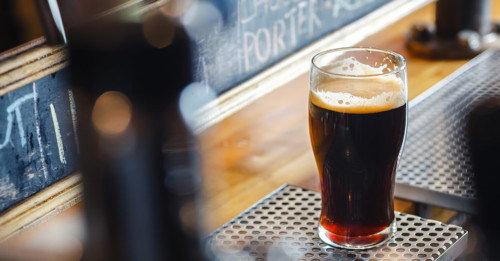You’ve probably heard of stout (ahem, Guinness). But porter came first. Not only did it come first, porter was actually popularized by Arthur Guinness himself, who brewed the stuff until alterations in recipe yielded a stronger, “stout porter” that eventually became the “stout” we all know and love and drink by default on St. Patrick’s Day. But the porter style is still out there—and expanding thanks to American craft brewing. A good option for anyone who likes the darker end of the beer spectrum and wants to explore some flavors outside of the stout world.
English Porter Essential Info
- Color: Light to dark brown (Brown) / Medium to darker brown (Robust)
- ABV: 4%-5.4% (Brown) / 4.8%-6.5% (Robust)
- Commercial Examples: Samuel Smith’s Taddy Porter, Fuller’s London Porter, Smuttynose Robust Porter
The original porter was born in the 1700s, supposedly the result of blending old (as in stale or sour), new (brown ale), and mild beers so as to make something palatable. But modern English porters come in two styles: Brown and Robust. Brown Porter is more malty than hoppy, with flavors like bittersweet chocolate, caramel, or toffee, without any significant quantity of roasted barley (the stuff that gives stout its coffee depth). In a sense, a Brown Porter is a kind of heftier Brown Ale. Robust Porter, as the name suggests, is a bit more intense, thanks to use of roasted and/or black patent malt, sometimes with accompanying substantial hops. Basically, and logically, a bit more robust (and a closer cousin to stout).
Baltic Porter Essential Info
- Color: Dark copper to dark brown
- ABV: 5.5%-10%
- Commercial Examples: Smuttynose Baltic Porter, Victory Brewing Co. Baltic Thunder, Baltika #6 Porter
Blurring the lines between porter and stouts, behold, the Baltic Porter. Basically an English Porter that’s been fortified with higher alcohol content to withstand a journey across the Baltic Sea, where the style continued to evolve thanks in part to influence from the Russian Imperial Stout style. It’s a porter that can drink like a stout[link to Stout entry page]. But while its malt flavors can get deliciously complex—molasses, chocolate, licorice, toffee—the roasted quality never quite veers to dark/burnt porter flavor. Instead you have a roundness that’s picked up on the burly shoulders of higher ABV and echoed by some fruity esters. American versions may be barrel-aged, upping the complexity.
American Porter Essential Info
- Color: Dark brown to black
- ABV: 5%-7.5% (Imperials higher)
- Commercial Examples: Stone Smoked Vanilla Bean Porter, Rogue Ales Mocha Porter, Great Lakes Brewing Co. Edmund Fitzgerald Porter
Inspired by English Porter, American Porters take the depth and complexity of the classic porter style to uncharted, craft brewed territories. As there are a few kinds of porter across the pond, so American Porter pay homage to the style in a few ways: using smoked malts to play up the roasty depths of a Robust Porter with a “Smoke Porter” style, or meeting (and surpassing) the higher ABV of the Baltic Porter with the American Imperial Porter style that can hit 10% ABV and beyond. But variety in American Porter, as in craft beer, abounds. Just expect malty complexity, possibly aggressive hops, and some freedom to play wildly in the dark side of the pool.
